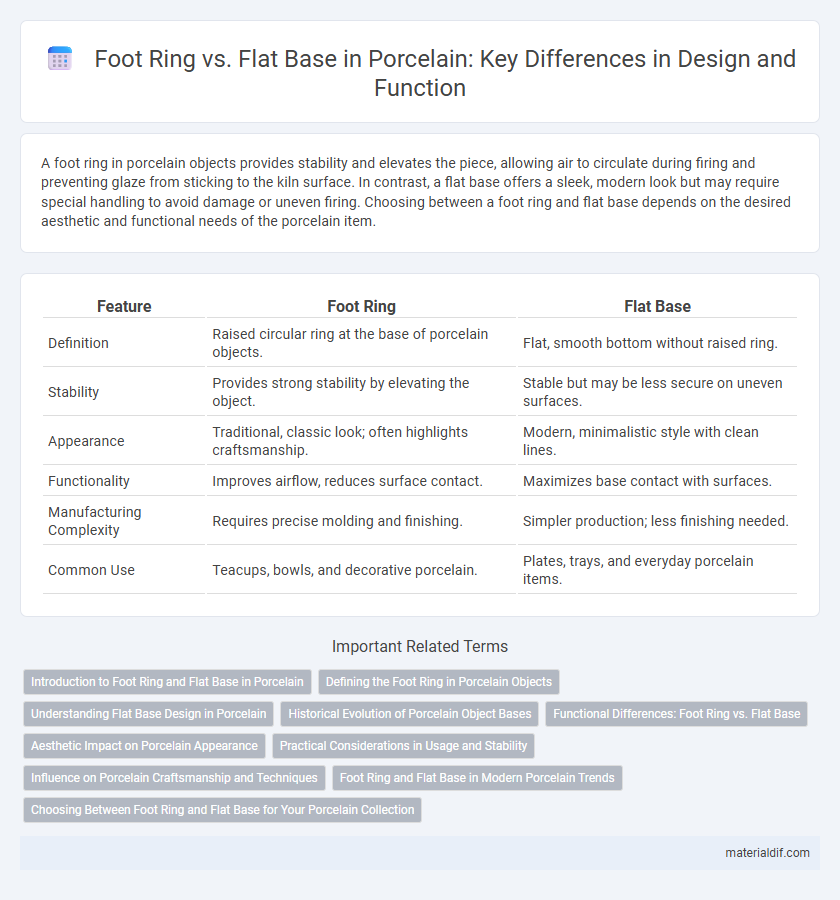A foot ring in porcelain objects provides stability and elevates the piece, allowing air to circulate during firing and preventing glaze from sticking to the kiln surface. In contrast, a flat base offers a sleek, modern look but may require special handling to avoid damage or uneven firing. Choosing between a foot ring and flat base depends on the desired aesthetic and functional needs of the porcelain item.
Table of Comparison
| Feature | Foot Ring | Flat Base |
|---|---|---|
| Definition | Raised circular ring at the base of porcelain objects. | Flat, smooth bottom without raised ring. |
| Stability | Provides strong stability by elevating the object. | Stable but may be less secure on uneven surfaces. |
| Appearance | Traditional, classic look; often highlights craftsmanship. | Modern, minimalistic style with clean lines. |
| Functionality | Improves airflow, reduces surface contact. | Maximizes base contact with surfaces. |
| Manufacturing Complexity | Requires precise molding and finishing. | Simpler production; less finishing needed. |
| Common Use | Teacups, bowls, and decorative porcelain. | Plates, trays, and everyday porcelain items. |
Introduction to Foot Ring and Flat Base in Porcelain
A foot ring in porcelain serves as a raised circular support that elevates the piece, providing stability and preventing direct contact with surfaces, which helps reduce wear and showcases the craftsmanship. In contrast, a flat base offers a smooth, level bottom that maximizes surface contact and stability but may be more susceptible to scratches and less elegant in display. Understanding the difference between foot ring and flat base is essential for collectors and manufacturers to assess the object's style, function, and period authenticity.
Defining the Foot Ring in Porcelain Objects
The foot ring in porcelain objects is a raised circular base that elevates the piece off surfaces, providing stability and reducing direct contact with tables or shelves. This structural feature helps prevent chipping and allows for even heat distribution during firing, maintaining the porcelain's integrity. Unlike flat bases, foot rings also enhance aesthetic appeal by creating a refined shadow line around the object's perimeter.
Understanding Flat Base Design in Porcelain
Flat base design in porcelain offers increased stability compared to foot ring bases, as the entire bottom surface makes direct contact with the table. This design is preferred in modern porcelain tableware for its minimalist aesthetic and ease of cleaning, eliminating the recessed area found in foot rings where dirt and moisture can accumulate. Manufacturing flat base porcelain requires precise kiln support to prevent warping, ensuring a perfectly level finish that enhances both functionality and visual appeal.
Historical Evolution of Porcelain Object Bases
Porcelain object bases evolved from simple flat bases to more intricate foot rings during the Tang dynasty, reflecting advancements in kiln technology and aesthetic preferences. Foot rings allowed better heat circulation and stability, becoming prominent in Ming and Qing dynasty ceramics, signifying refined craftsmanship. These bases also facilitated stacking and display, influencing the functional design of porcelain in historical and commercial contexts.
Functional Differences: Foot Ring vs. Flat Base
A foot ring in porcelain objects elevates the piece, providing stability and reducing direct contact with surfaces, which helps prevent heat damage and facilitates stacking. In contrast, a flat base offers broader surface contact, increasing stability on uneven surfaces but making the item more prone to heat transfer and slipping. Functional differences impact not only the porcelain's usability but also its aesthetic presentation and manufacturing complexity.
Aesthetic Impact on Porcelain Appearance
The foot ring on porcelain objects elevates the piece, creating a delicate shadow that enhances the visual depth and elegance of the design. In contrast, a flat base offers a seamless silhouette that emphasizes the smoothness and solidity of the porcelain surface. The choice between foot ring and flat base significantly influences the overall aesthetic, affecting light reflection and the viewer's perception of craftsmanship.
Practical Considerations in Usage and Stability
Foot rings in porcelain objects enhance stability by elevating the piece slightly, reducing direct contact with surfaces and minimizing the risk of scratching or heat damage. Flat bases provide a broader, more stable contact area ideal for heavier or wider items, ensuring balance during use. Choosing between foot ring and flat base depends on the object's intended function, with foot rings favored in delicate display pieces and flat bases preferred for practical, everyday use.
Influence on Porcelain Craftsmanship and Techniques
The choice between foot ring and flat base significantly impacts porcelain craftsmanship, as foot rings require precise trimming and firing techniques to ensure stability and elegance, demanding higher skill from artisans. Foot rings elevate the porcelain object, allowing better heat distribution during firing, which enhances glaze quality and reduces defects like warping or cracking. Flat bases simplify production but may limit aesthetic refinement and heat circulation, influencing the final texture and durability of porcelain pieces.
Foot Ring and Flat Base in Modern Porcelain Trends
Foot rings in modern porcelain emphasize stability and elevate the object, allowing for better heat distribution and aesthetic appeal, especially in functional items like bowls and teacups. Flat bases provide a seamless, minimalist look favored in contemporary designs, enhancing the object's sleekness and making it suitable for stackable or display pieces. The choice between foot ring and flat base aligns with trends prioritizing both form and function, reflecting evolving consumer preferences in porcelain craftsmanship.
Choosing Between Foot Ring and Flat Base for Your Porcelain Collection
Selecting between a foot ring and a flat base for porcelain pieces depends on stability, aesthetic preference, and context of display. Foot rings elevate the porcelain, offering better balance and reducing contact with surfaces, which helps protect delicate glazes and add a sense of elegance. Flat bases provide a contemporary look with direct contact, ideal for sturdy display and ease of stacking in a porcelain collection.
Foot Ring vs Flat Base (in porcelain objects) Infographic

 materialdif.com
materialdif.com